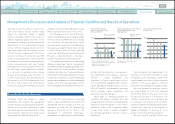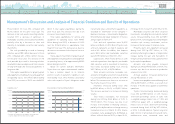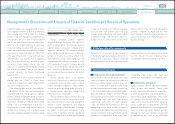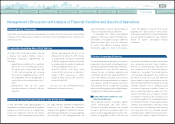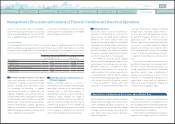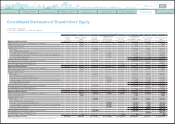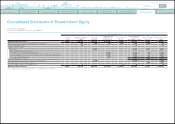Toyota 2012 Annual Report Download - page 73
Download and view the complete annual report
Please find page 73 of the 2012 Toyota annual report below. You can navigate through the pages in the report by either clicking on the pages listed below, or by using the keyword search tool below to find specific information within the annual report.
TOYOTA ANNUAL REPORT 2012
Toyota Global Vision Changes for Making
Ever-Better Cars President
ʼ
s Message Medium- to Long-Term
Growth Initiatives Special Feature Management and
Corporate Information Investor Information
Business and
Performance Review Financial Section
Management's Discussion and Analysis of Financial Condition and Results of Operations
Toyota
ʼ
s accrued estimated warranty costs, it
would negatively affect future operating results of
the automotive operations.
An estimate of warranty claim accrued
for each fiscal year is calculated based on the
estimate of warranty claim per unit. The estimate
of warranty claim per unit is calculated by dividing
the actual amounts of warranty claim, net of
claim recovery cost received from suppliers, by
the number of sales units for the fiscal year.
As the historical recovery amounts received
from suppliers is used as a factor in Toyota
ʼ
s
calculation of estimated accrued warranty cost,
the estimated accrued warranty cost may change
depending on the average recovery amounts
received from suppliers in the past. However, Toyota
believes that there is not a significant uncertainty of
estimated amounts based on historical experience
regarding recoveries received from suppliers.
Toyota may seek recovery to suppliers over the life
of the warranty, and there are no other significant
special terms and conditions including cap on
amounts that can be recovered.
Toyota accrues for costs of recalls and other
safety measures, as well as product warranty
cost described above, included as a component of
cost of sales, at the time of vehicle sale based on
the amount estimated from historical experience
with consideration of individual occurrences of
recalls and other safety measures.
Below are the important factors, judgments
and assumptions taken into account for estimating
costs of recalls and other safety measures.
fair value and adequacy of collateral, and other
pertinent factors. This evaluation is inherently
judgmental and requires material estimates,
including the amounts and timing of future
cash flows expected to be received, which may
be susceptible to significant change. Although
management considers the allowance for doubtful
accounts and credit losses to be adequate based
on information currently available, additional
provisions may be necessary due to
(
i
)
changes
in management estimates and assumptions
about asset impairments,
(
ii
)
information that
indicates changes in expected future cash flows,
or
(
iii
)
changes in economic and other events and
conditions. To the extent that sales incentives
remain an integral part of sales promotion with
the effect of reducing new vehicle prices, resale
prices of used vehicles and, correspondingly,
the collateral value of Toyota
ʼ
s retail receivables
and finance lease receivables could experience
further downward pressure. If these factors
require a significant increase in Toyota
ʼ
s allowance
for doubtful accounts and credit losses, it could
negatively affect future operating results of the
financial services operations. The level of credit
losses, which has a greater impact on Toyota
ʼ
s
results of operations, is influenced by two factors:
frequency of occurrence and expected severity
of loss. For evaluation purposes, exposures
to credit losses are segmented into the two
primary categories of
“
consumer
”
and
“
dealer
”
.
Toyota
ʼ
s
“
consumer
”
category consists of smaller
balances that are homogenous retail receivables
Toyota accrues for cost of recalls and other
safety measures based on the average repair
cost per unit and pattern of payment occurrence
in the past at the time of product sale. The
average repair cost per unit is calculated based
on historical expenses incurred in relation of
recalls and other safety measures.
Factors that may bring material uncertainties
to the estimated or actual amount include the
important changes in the average repair cost for
products.
Retail receivables and finance lease receivables
consist of retail installment sales contracts
secured by passenger cars and commercial
vehicles. Collectability risks include consumer
and dealer insolvencies and insufficient collateral
values
(
less costs to sell
)
to realize the full
carrying values of these receivables. As a matter
of policy, Toyota maintains an allowance for
doubtful accounts and credit losses representing
management
ʼ
s estimate of the amount of asset
impairment in the portfolios of finance, trade
and other receivables. Toyota determines the
allowance for doubtful accounts and credit losses
based on a systematic, ongoing review and
evaluation performed as part of the credit-risk
evaluation process, historical loss experience,
the size and composition of the portfolios, current
economic events and conditions, the estimated
and finance lease receivables. The
“
dealer
”
category consists of wholesale and other dealer
loan receivables. The overall allowance for credit
losses is evaluated at least quarterly, considering
a variety of assumptions and factors to determine
whether reserves are considered adequate to
cover probable losses.
The level of credit losses, which could significantly
impact Toyota
ʼ
s results of operations, is influenced
by two factors: frequency of occurrence and
expected severity of loss. The overall allowance
for credit losses is evaluated at least quarterly,
considering a variety of assumptions and factors
to determine whether reserves are considered
adequate to cover probable losses. The following
table illustrates the effect of an assumed change
in frequency of occurrence or expected severity
of loss mainly in the United States, assuming
all other assumptions are held consistent
respectively. The table below represents the
impact on the allowance for credit losses in
Toyota
ʼ
s financial services operations of the
change in frequency of occurrence or expected
severity of loss as any change impacts most
significantly on the financial services operations.
■
Allowance for Doubtful Accounts and
Credit Losses
Natures of estimates and assumptions
Sensitivity analysis
Yen in millions
Effect on the allowance
for credit losses
as of March 31, 2012
10 percent change in frequency of
occurrence or expected severity
of loss ¥4,110
0820
Search NextPrev page 73
Contents







